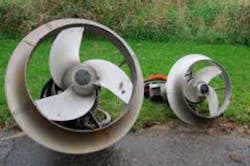Enhancing Efficiency
The Madison Metropolitan Sewerage District (MMSD) manages regional wastewater service for the Madison, Wis., area, providing wastewater collection and treatment for 43 municipal customers, including cities, villages and utility and sanitary districts. With a total service area of about 180 sq miles, MMSD serves a population of approximately 330,000 and handles an average daily wastewater volume of 42 mgd. All wastewater collected within the MMSD system is conveyed to and treated at MMSD’s Nine Springs Wastewater Treatment Plant (WWTP), an enhanced biological phosphorus removal conventional activated sludge facility.
Scope
In 2012, the plant decided to reduce energy consumption. An evaluation of the mixing system was conducted in the biological selector basins. It revealed the potential for significant energy savings due to already installed process improvements and repositioning the mixers for more efficient production of bulk-flow velocity.
By removing heavier solids using grit removal and fine screening prior to biological treatment, less energy was required to suspend the remaining solids in the selector basins.
Given the new process conditions, MMSD solicited equipment proposals for reduced mixer sizes to replace the 16-year-old Flygt Model 4650 submersible mixers in the biological selector basins. A unique aspect of these proposals was that each required a trial mixer to evaluate the actual plant performance. This would allow the electrical and mechanical maintenance crews to evaluate the equipment under field conditions.
Field Trial
Xylem proposed replacing the larger mixers in the biological selector basins with smaller, low-energy mixers—the Flygt Model 4630, 2.5 hp. The operators at MMSD realized that selecting Flygt as the supplier would result in a system that is fully compatible with the existing over-temperature and seal-fail monitoring systems. Additionally, of all the offered solutions, choosing Flygt would result in the easiest installation of a fully functional mixing system.
Solution
Based on the results of the trial and observations of MMSD staff, Nine Springs WWTP selected Flygt over four other vendors. In 2013, the plant moved forward with Phase 1 of its project, installing the Flygt Model 4630 mixers in 26 of the biological selector basins. In 2015, Phase 2 of the project involved replacing the remaining ten selector zone mixers with Flygt model 4640 4-hp mixers in zones that required additional mixing energy.
Flygt compact mixers were chosen not only for the lower cost and energy savings, but also because they easily blend highly contaminated fluids, high-density or high-viscosity liquids, and liquids with fibrous material. The space-saving mixers also include compact, robust direct-drive motors, large-volume oil housings, zero leakage, non-clogging fiber-handling hydraulics and higher available efficiencies with an optional jet ring. Any tank’s guide bar system combined with Flygt’s lifting equipment enables easy access for inspection and service.
Result
MMSD is able to report more than $100,000 in annual energy savings without compromising the integrity of the biological treatment process.
After only three months, the performance of Phase 1 was meeting projections, and the estimated payback on the project will be under three years. Once the Phase 2 installation is fully operational, the new mixing system is projected to use approximately 40% of the previous energy consumption.
